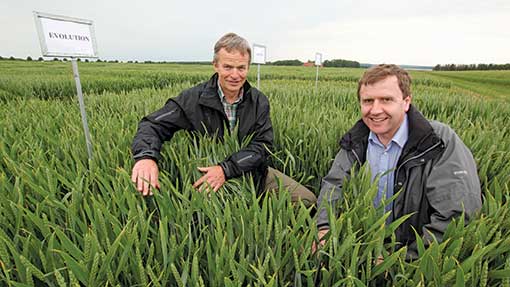Danish wheat breeder brings disease resistance to UK

A collaboration between Danish and British breeders will bear its first fruits this autumn as a new hard feed wheat comes to the UK market. Adam Clarke went to Denmark to find out how their low-input system has helped its selection.
Selecting for varieties against a backdrop of low crop inputs is helping Danish breeders select cereal varieties with robust disease resistance and better nutrient use efficiency.
Farmers in the Scandinavian country are subjected to some of the tightest regulation in the world, limiting their nitrogen use to sub-optimal levels and pesticides are taxed heavily to discourage overuse.
Depleted oxygen in the inland waters on the Danish peninsula was blamed on agricultural nutrient pollution and triggered an environmental water plan in 1987, which has been reviewed and tightened numerous times since.
See also: ‘More sprays needed to control wheat diseases’
Between 1987 and the present day, nitrogen use has been halved from 400,000t a year to about 200,000t, leading to struggles with grain protein levels in wheat and barley crops.
A recent change in the pesticide tax legislation has also resulted in some pesticide compounds being taxed at a rate of 1,000% over its base price forcing growers to use chemicals perceived less harmful and at lower doses.
Birger Eriksen, director of plant breeder Sejet (pronounced Sey-et) told Farmers Weekly on a recent Denmark visit that the government are endlessly turning the screw on farmers for the environmental cause.
He and many others now feel enough is enough, but one positive to materialise is that it’s enabled plant breeders to select plants that are performing well in a pressurised situation.
“In our variety trials we use lower fungicide doses than even growers do, so they are tested extremely rigorously in the face of these greening measures,” says Mr Eriksen.
“Evolution has the high-yield potential, but an added insurance of good disease resistance, so in the face of changes in the yellow rust races and high septoria, it can compliment other high input varieties well.”
Ed Flatman, Limagrain UK wheat breader
On similar latitude to northern England and Scotland, Denmark’s key diseases are septoria and yellow rust in the 700,000-plus ha of winter wheat grown in the country.
Sejet plant breeder Finn Borum explained that all genetic lines used to be treated the same in their breeding programme, but a co-operative agreement between Sejet and fellow breeder Limgrain aims to identify varieties for the slightly different market requirements of France, Germany, Denmark and the UK.
“Now, we always work with the specific markets in mind and the winter wheat variety Evolution is certainly a result of that,” he added.
The first variety from the co-operative to receive full recommendation by the HGCA is Limagrain’s hard Group 4 feed wheat, Evolution, which matches the highest yielding variety on the Recommended List, at 107% of control.
The big draw for many growers will be it’s agronomic package, which includes scores of 9 for both yellow and brown rust and a solid 6 for septoria, eyespot and fusarium ear blight.
Durability
Mr Borum explained disease resistance is robust, as it’s not expressed with a single gene like other high yielding varieties, which have broken down to yellow rust in the past.
“It has remained resistant to all the races that are currently found in the field as it has ‘stacked’ resistance genes,” said Mr Borum.
Limagrain’s UK wheat breeder Ed Flatman said Evolution is susceptible to yellow rust at the seedling stage, but grows away from any early infection and maintains solid resistance into the latter part of the season.
The UK feed wheat market is dominated by Group 4 wheat varieties, which presume a 71% share and of those top yielders Kielder and Santiago have weakness on disease, particularly mildew and yellow rust.
“Evolution has the high-yield potential, but an added insurance of good disease resistance, so in the face of changes in the yellow rust races and high septoria, it can compliment other high input varieties well.
“If fungicide timings do slip, it can provide a useful management tool to focus disease control measures on varieties with higher disease risk,” said Mr Flatman.
Evolution’s robust disease characteristics also make it an ideal candidate for the second or continuous wheat situations, with a useful 6 for eyespot. This year, UK trials with Evolution are investigating if the variety could be more efficient at using nitrogen, enabling inputs to be reduced.
However, the variety has no orange wheat blossom midge (OWBM) resistance and Mr Flatman also warned it is not suited to early drilling due to its fast vegetative growth.
“Growers in high-risk areas for midge will recognise the need for resistance, but pest incidence has been falling and much depends on the year,” said Mr Flatman.

